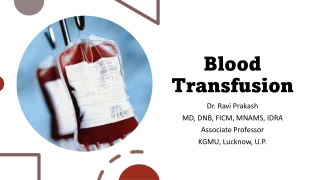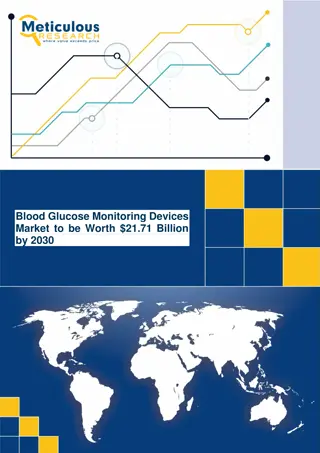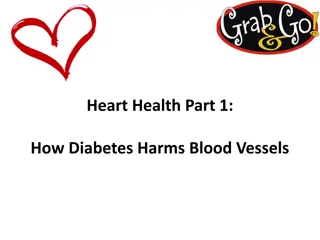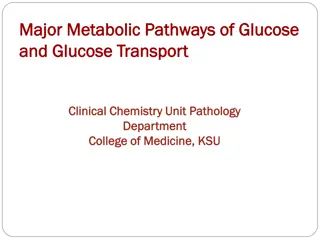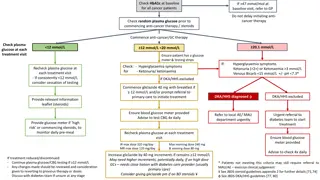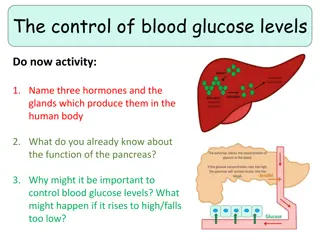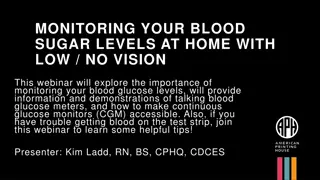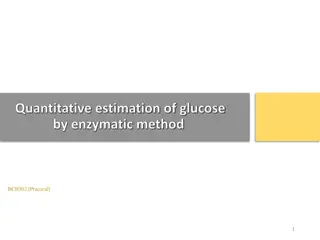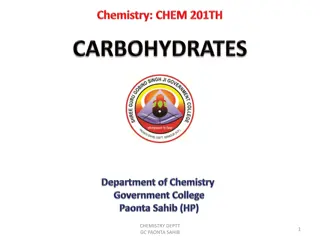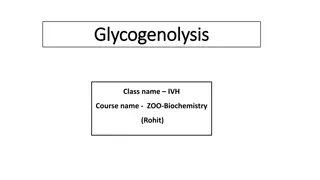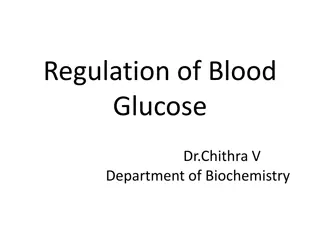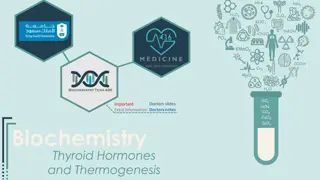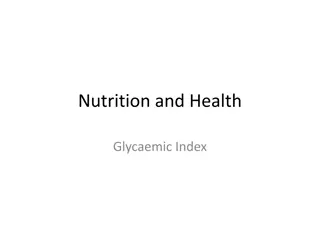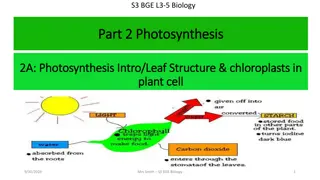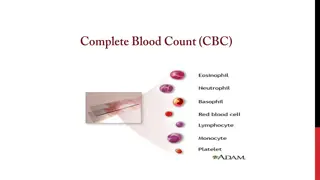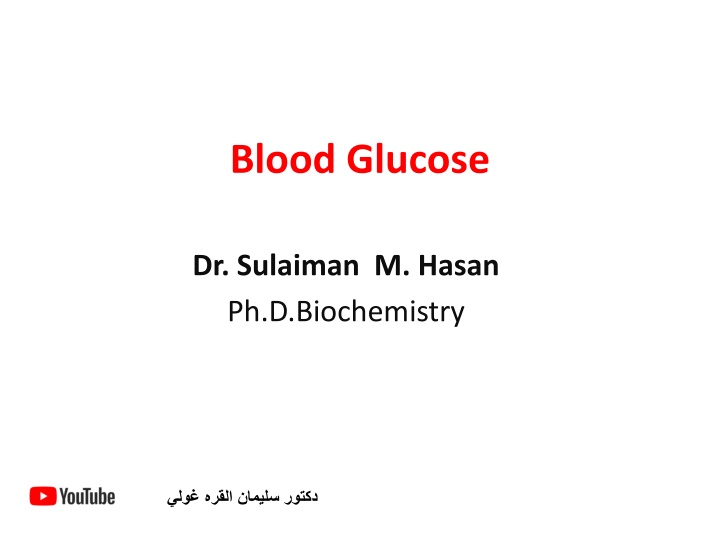
Blood Glucose and Testing
Blood glucose, or blood sugar, is crucial for energy production in your body. Learn about its synthesis, testing, and when to get tested for optimal health monitoring.
Download Presentation

Please find below an Image/Link to download the presentation.
The content on the website is provided AS IS for your information and personal use only. It may not be sold, licensed, or shared on other websites without obtaining consent from the author. If you encounter any issues during the download, it is possible that the publisher has removed the file from their server.
You are allowed to download the files provided on this website for personal or commercial use, subject to the condition that they are used lawfully. All files are the property of their respective owners.
The content on the website is provided AS IS for your information and personal use only. It may not be sold, licensed, or shared on other websites without obtaining consent from the author.
E N D
Presentation Transcript
Blood Glucose Dr. Sulaiman M. Hasan Ph.D.Biochemistry
Determination of Blood Glucose Blood glucose, or blood sugar, is the main sugar found in your blood. It is your body's primary source of energy. It comes from the food you eat. Your body breaks down most of that food into glucose and releases it into your bloodstream. Structure:
Glucose is synthesized in the liver when dietary sources of glucose are not available from glycogen (glycogenolysis) or from another sources such as lipid and protein (gluconeogenesis). All cells use glucose as an important energy source. Some tissues (e.g. the central nervous system, the brain and spinal cord) depend entirely on glucose. Glucose is stored in muscle and liver as glycogen by insulin hormone
Glucose Tests Also known as: Blood Sugar; Fasting Blood Sugar(FBS), Fasting Blood Glucose (FBG), Random Blood Sugar (R.B.S), Random Blood Glucose (RBG), Oral Glucose Tolerance Test (OGTT) , Urine Glucose. Why Get Tested? To determine if your blood glucose level is within a healthy range; to screen for and diagnose diabetes and prediabetes and to monitor for high blood glucose (hyperglycemia) or low blood glucose (hypoglycemia); to check for glucose in your urine.
When to Get Tested? Blood glucose: when you are older than 45 years or have risk factors for diabetes, when you have symptoms suggesting high or low blood glucose, during pregnancy, when you are diabetic, self-checks up to several times a day to monitor blood glucose levels. Urine glucose: usually as part of a urinalysis.
Test Preparation Needed? 1. In general, it is recommended that you fast (nothing to eat or drink except water) for at least 8 hours before having a blood glucose test. 2. For people with diabetes, glucose levels are often checked both while fasting and after meals to provide the best control of diabetes. 3. Preferably take the sample in the morning after an overnight fasting. 4. No extraordinary exercises before test. 5. No trauma, severe infection or recently recovered from serious illness. 6. No drugs that effect on the glycemic status of the body such as cortisone or diuretics. 7. No smoking before or during the test.
Screening and Diagnosis 1. Fasting glucose (fasting blood glucose, FBG) : this test measures the level of glucose in the blood after fasting for at least 8 hours. 2. Glucose tolerance test (GTT) : for this test, the person has a fasting glucose test done, then drinks a 75-gram glucose drink. Another blood sample is drawn 1 hours after the glucose drink and after 2 hours. This protocol "challenges" the person's body to process the glucose. Normally, the blood glucose level rises after the drink and stimulates the pancreas to release insulin into the bloodstream. Insulin allows the glucose to be taken up by cells. As time passes, the blood glucose level is expected to decrease again. When a person is unable to produce enough insulin, or if the body's cells are resistant to its effects (insulin resistance), then less glucose is transported from the blood into cells and the blood glucose level remains high.
3. A different test called hemoglobin A1c (HbA1c) may be used as an alternative to glucose testing for screening and diagnosis.
Monitoring Diabetics must monitor their own blood glucose levels, often several times a day, to determine how far above or below normal their glucose is and to determine what oral medications or insulin(s) they may need. This is usually done by placing a drop of blood from a skin prick onto a glucose strip and then inserting the strip into a glucose meter, a small machine that provides a digital readout of the blood glucose level.
Urine glucose Urine glucose is one of the substances tested when a urinalysis is performed. A urinalysis may be done routinely as part of a physical or prenatal checkup. The health practitioner may follow up an elevated urine glucose test with blood glucose testing. Urine glucose testing is a screening tool, but it is not sensitive enough for diagnosis or monitoring.
When is it ordered? Several health organizations, including the American Diabetes Association (ADA) and the U. S. Preventive Services Task Force (USPSTF), recommend diabetes screening when a person is age 45 or older or when a person of any age has risk factors. Examples of risk factors include: 1. Overweight, obese, or physically inactive. 2. Awoman who delivered a baby weighing more than 9 pounds or with a history of gestational diabetes.
3. Awoman with polycystic ovarian syndrome. 4. High blood pressure (hypertension) or taking medication for high blood pressure. 5. Low HDL cholesterol level (less than 35 mg/dL or 0.90 mmol/L) and/or a high triglyceride level (more than 250 mg/dL or 2.82 mmol/L). 6. History of cardiovascular disease (CVD). If the screening test result is within normal limits, the ADA recommends retesting within 3 years.
A blood glucose test may also be ordered when someone has signs and symptoms of high blood glucose (hyperglycemia), such as: 1. Increased thirst, usually with frequent urination 2. Fatigue 3. Blurred vision 4. Slow-healing wounds or infections
symptoms of low blood glucose (hypoglycemia), such as: 1. Sweating 2. Hunger 3. Trembling 4. Anxiety 5. Confusion 6. Blurred vision

